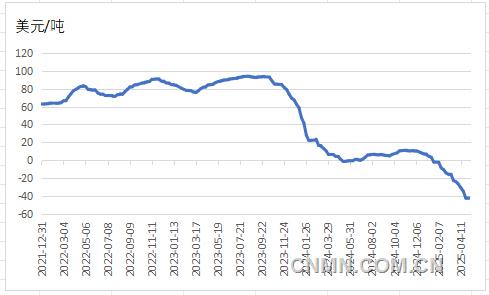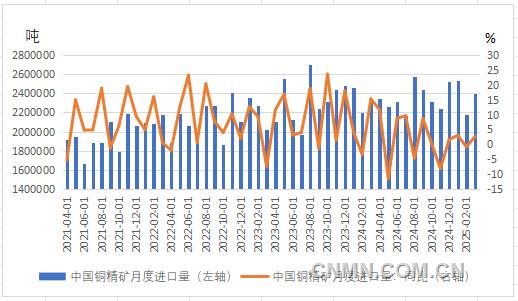








SMM Imported Copper Concentrate Index

China's Monthly Copper Concentrate Imports
Recently, the copper market has shown stability, with copper prices continuing to fluctuate rangebound near the 5-day moving average. The suppressive effect of the macro market on copper prices has significantly weakened, and fundamental support is clear. LME copper has performed relatively stronger than SHFE copper, which is somewhat related to the changes in copper inventory structure caused by overseas arbitrage in the earlier period.
On the macro front, the US Fed did not take interest rate cut action at its May policy meeting, keeping the target range for the US federal funds rate unchanged at 4.25%-4.5%. This marks the third consecutive monetary policy meeting where the Fed has decided to pause interest rate cuts, in line with market expectations. Two days after the Fed announced its latest interest rate decision, more than half of the Fed's policy makers made public speeches, with multiple officials emphasizing the importance of controlling inflation expectations and believing that uncertainties in trade policy could keep interest rates higher for longer. According to tools from the Chicago Mercantile Exchange (CME), the futures market expects a higher probability of the Fed not cutting interest rates in June and a higher probability of a cut in July.
Recently, market concerns about the foreign trade environment have significantly eased. Following the Geneva Economic and Trade Conference, China and the US issued a joint statement, announcing the cancellation of 91% of tariffs, the suspension of 24% of tariffs, and the retention of a 10% base tariff. This has led to a rebound in global market risk appetite. In addition, the UK and the US have reached an agreement on the terms of a tariff and trade deal. The easing of foreign trade environment concerns continues to benefit the non-ferrous metals sector. Against the backdrop of easing foreign trade concerns, the US dollar has continued to strengthen, and in the short term, the overseas macro environment will continue to provide some support to copper prices.
From the perspective of global exchange inventories, as of May 14, LME copper inventories decreased by 12,125 mt from April 30 to 185,600 mt. Earlier LME and COMEX arbitrage operations have led to a continuous decline in LME copper inventories, increasing supply pressure in the LME market. SHFE copper inventories continued to decrease by 8,602 mt to 80,700 mt. Since March, SHFE copper inventories have been on a continuous decline, with low smelter processing fees and a rebound in downstream consumption deepening domestic supply issues. COMEX copper inventories increased by 23,017 mt from before the Labour Day holiday to 167,000 mt, which is somewhat related to the arrival of goods from earlier arbitrage operations.
After the Labour Day holiday, the ratio between the overseas and domestic markets fluctuated slightly, basically remaining within the range of 8.196-8.218, which is relatively weaker compared to the ratio range before the holiday. The decline in LME market inventories has led to a sustained strong performance of spot copper, with the continuous expansion of LME spot premiums having a significant impact on the ratio between the overseas and domestic markets. Considering the earlier overseas copper arbitrage, the tightness of LME spot copper is still expected to further intensify, which will drive the ratio between the overseas and domestic markets to move lower again.
In terms of supply, the belt conveyor terminal at Patache Port was damaged during operations due to a collision with a vessel. Cargo loading operations at the port were suspended two weeks ago, and repairs are expected to take at least two months. Before the repairs are completed, Collahuasi copper concentrates previously shipped through Patache Port will be transported by truck from the neighboring ports of Mejillones and Angamos, with no significant impact on the shipment of Collahuasi copper concentrates. However, the production situation of overseas mines in Q1 was not optimistic, with copper concentrate production from miners such as Freeport, Glencore, and Anglo American experiencing rapid YoY declines. The tight supply of ore persists. From the weekly imported copper concentrate TCs reported by SMM, as of the week ending May 9, the imported copper concentrate TCs were reported at -$43.11/mt, with the negative value continuing to deepen, raising market concerns about the supply of copper cathode. Currently, the imported copper concentrate TCs have remained negative for three consecutive months and continue to weaken. According to the SMM survey, the number of domestic smelters planning maintenance in Q2 has increased significantly. In April, the total crude smelting capacity under maintenance in China was 700,000 mt, and the total refined smelting capacity under maintenance was 980,000 mt. The impact of maintenance was relatively larger in April compared to May and June. The impact on copper cathode supply due to maintenance will continue to be reflected in the near term, providing short-term support for copper prices.
In terms of demand, there are currently certain differences in the performance of intermediate consumption links. In April, the operating rates of copper cathode rod, secondary copper rod, copper plate/sheet and strip, enamelled wire, and copper foil enterprises increased MoM, while the operating rates of copper pipe & tube and brass billet enterprises decreased MoM. Previously, the decline in copper prices had a certain stimulating effect on downstream consumption. However, as copper prices continue to recover, consumption is expected to stabilize after a short-term concentrated release.
From the perspective of end-use demand for copper, the demand performance of the wire & cable and automotive industries has remained generally stable. Among them, wire & cable consumption continues the pattern of last year, with power supply consumption remaining active and real estate demand generally stable. The operating levels of copper cathode rod enterprises this year are better than in the previous two years, mainly due to insufficient production of secondary copper rod. The finished product inventories of copper cathode rod enterprises have already been high, and the high raw material inventories accumulated since year-end continue to put pressure on enterprises, making it difficult for the consumption rebound to effectively form new consumption boosts. Currently, the automotive industry is in a seasonal rebound phase. However, as the trade-in subsidies for the automotive industry have been in place for several years, some demand has already been fulfilled in advance. Therefore, the actual boosting effect of consumption on production is expected to be relatively limited, with the seasonal rebound effect persisting. The production and sales of the air conditioning industry have distinct seasonal characteristics. It has now entered the downward cycle of air conditioning production, and air conditioning inventories have accumulated again at a high level. Therefore, the demand for copper in the air conditioning industry will decline in line with seasonal patterns.
Overall, the fundamentals will provide short-term support for copper prices, which will continue to fluctuate at highs.
(Author's affiliation: Guoyuan Futures)
For queries, please contact Lemon Zhao at lemonzhao@smm.cn
For more information on how to access our research reports, please email service.en@smm.cn